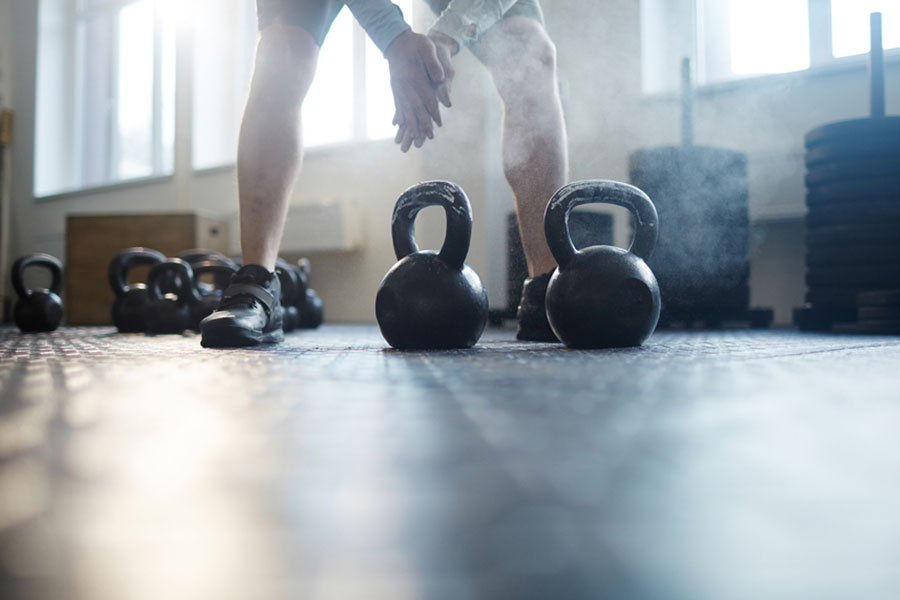When it comes to getting in shape, people are always looking for new and innovative ways to do it. But we are taking you to the basics by introducing you to one of the most versatile, effective, yet affordable pieces of equipment- kettlebells.
They definitely limp in front of their heavier and more intimidating cousins, the barbells or even dumbbells, but that's just appearance. In reality, kettlebells are perfect for gaining muscle mass, losing fat, and building strength and endurance. Kettlebells are one of the most versatile strength training equipment that allows you to perform various exercises.
And if you don't believe us, try these 6 steps with kettlebells and be amazed at the positive transition that comes around too easy, too fast!
So let's unravel all the secrets of the seemingly very humble Mr. Kettlebell.
Why are Kettlebells Great for Building Muscle?
Kettlebells are a great way to build muscle. For one thing, they're versatile. This means you can engage multiple muscle groups with just one piece of weight-lifting equipment. They're also great for building explosive power. That's why many athletes use kettlebells to train for their sports.
But kettlebells aren't just for athletes. They're great for regular people, too. Kettlebells are the way to go if you want to get stronger and build more muscle
There are a lot of different ways to build muscle. You can lift weights, do push-ups, or even just eat a lot of protein. But if you're looking for an effective and fun workout, you can't go wrong with kettlebells.
Kettlebells are one of the smartest tools for building muscle because they provide resistance in all directions. Unlike dumbbells, which only resist gravity, kettlebells also resist the centrifugal force created when you swing them around. This makes your muscles work harder, which leads to more growth.
Related Article: The Best Kettlebell Exercises for At-Home Workouts
The Benefits of Training With a Kettlebell
Let's go through the most notable benefits of kettlebell training.
Provides Both Cardio and Strength Training Benefits
Kettlebell workouts are most effective with higher reps, recruiting multiple muscles simultaneously. If you can keep your speed consistent, you might as well turn your kettlebell workout into HIIT, reaping solid cardio benefits. That means they are directly helping you lose weight, supercharge your good hormones, and even burn more calories.
Kettlebell training improves cardio and overall strength and helps with your balance, according to new research from the American Council on Exercise (ACE). Furthermore, those who circuit trained with kettlebells three times per week saw an increase in their VO2 max by 6% in under one month's time period, according to NSCA's TSAC Report.
Strengthens the Entire Posterior Chain
Most people focus on working their "mirror muscles" - the ones they can see when they look in the mirror. But neglecting your posterior chain muscles can lead to injury down the line. Kettlebells are a great way to work these muscles, which include your glutes, hamstrings, and erector spinae.
The posterior chain (muscles at the back side of your body) is responsible for keeping your spine straight, so it's important to keep it strong. Kettlebell swings are a great way to do this, as they simultaneously work all the muscles in the chain. They also improve your balance and coordination and keep backaches at bay.
Improves Strength and Stability
Kettlebell workouts are just perfect for those trying to harness more strength and stability. Unlike evenly balanced dumbbells, kettlebells have their weight offset from the handle. This design makes them ideal for exercises that involve swinging or lifting, as it challenges your muscles in new ways.
In addition, kettlebells are often smaller and easier to grip than traditional dumbbells, making them ideal for people with limited space or who want to work out at home. And because they come in various weights, kettlebells can be used by people of all fitness levels.
Increases the Range of Motion
A kettlebell is more than just a hunk of metal with a handle. It's a tool that can help you move better in multiple planes of motion. Unlike traditional dumbbells, mostly used in a single plane of motion (usually up and down), kettlebells can be swung in multiple directions.
This helps improve your range of motion and mobility. In addition, the offset weight of the kettlebell challenges your stabilizer muscles, resulting in better balance and coordination.
Fixes Muscle Imbalances
Muscle imbalances are more common than we think but a lot less scary than our imagination because getting rid of muscle imbalances is only a kettlebell away. Kettlebell workouts are an effective way to fix these imbalances.
By working both sides of the body equally and separately, kettlebell exercises allow you to balance your physique without any complicated procedures. In addition, the swinging motions of kettlebell exercises help build core strength and improve posture. As a result, kettlebell workouts are an excellent way to address muscle imbalances and reduce the risk of injury.
Related Article: Kettlebells – Everything You Need to Know About This Ultimate Exercise Equipment
6 Steps to Building Muscles With Kettlebells
Now that we know that kettlebells are perfect for building a strong, resilient and flexible body, we are presenting our 6 steps formula that ensures you make the perfect use of your kettlebell time.
1. Use the Correct Reps & Sets
The more, the better. Is that how you think? You should stop because when it comes to kettlebells, you must proceed with calculated sets and reps. How many reps and sets depend upon your goals.
If you want to build strength, gain muscle, or perhaps up your endurance level a notch, you'll do a specific number of reps and sets for each of these goals.
Strength: 1-6
Muscle Growth: 7-15
Endurance: 16+
To build muscle using kettlebells, ensure that every set falls between 7-15 reps. That's very important because If the weight is too heavy, then you'll only build strength, tiring out before reaching the 7th rep. On the other hand, if the weight is too light, you'll easily go past 15 reps and start building endurance instead of new muscle.
Rule of thumb?
You should have enough energy to go for another or two reps at the end of your workout for muscle growth. As far as sets are concerned, even one set of 7-15 is enough, but you can go for 3 sets for optimum results. So, you see, the reps and sets are crucial for kettlebells.
2. Employ Progressive Overload
A kettlebell is a great tool that offers multiple benefits, but definitely not the one you'd want to toy around with. If you are starting a kettlebell workout, you must ensure that you are proceeding with a progressive workload to avoid undue injuries.
You can increase the weight on the kettlebell when your body is conditioned to. Don't go head first into the valley of big weights. Slow and steady!
3. Choose Muscle Building Exercises
If you want to build muscles with a kettlebell and not slip off into the realms of endurance or simply strength building, you have to be more careful regarding your chosen exercises.
You can't just do any exercise with a kettlebell in your hand when you want a specific outcome- muscle building. There are particular muscle-building exercises that you want to do, like Kettlebell clean and press, Kettlebell lunges, Kettlebell rows, Kettlebell single-leg deadlifts, etc.
4. Focus on Nutrition
Good nutrition is an inevitable factor of any kind of workout, let alone kettlebell. This one just can't be avoided. So, when you are on a mission to build more muscle, you have to be super-efficient about eating the right food.
Eat more protein-based foods ( chicken, eggs, sweet potatoes, salmon, fish, quinoa, Greek Yogurt, etc.), so your muscles have all the necessary nutrients in place when it's time for them to grow. At the same time, you'd want to watch out for bad fats, so your muscle gains aren't overshadowed by higher body fat ratios.
5. Create Muscle Balance
Keep a balance between your targeted muscles, and you can achieve balanced gains. When you do legs, go for upper body exercises, too, and if you are targeting your core, don't neglect the legs. Muscle balance means strength, stability, and improved posture.
A balanced physique makes you much less likely to injure yourself. So, bulking with kettlebells should be a balanced affair!
6. Take Your Recovery Seriously
Building muscles with kettlebells is a great idea because there are so many ways kettlebells are better than other free weights, but that doesn't mean you should be lifting every day. Recovery is extremely important. You must let your body relax and build new muscles after tearing those existing ones with your kettlebells.
Without resting appropriately, you might as well just not work out at all because you won't build new muscles so efficiently. It's that simple!
FAQs
1. What does the kettlebell swing strengthen?
Kettlebell swings are a full-body workout that mostly concentrates on the posterior chain muscles (back of the body). The major muscles used and strengthened during this exercise include the glutes, hamstrings, erector spinae, and upper back muscles.
2. What are some disadvantages of using kettlebells?
Unless you know how to use your muscles properly, kettlebell exercises can lead to injury. If you have back pain, be EXTREMELY careful when starting with kettlebells because the incorrect technique can further damage your condition.
3. Why are kettlebells better than dumbbells?
Standard kettlebell exercises provide a better cardio workout than dumbbells because they require more movement. The swinging action of kettlebells also creates a smoother, more fluid movement that is easier on your body. And as an added bonus, the swing can target and activate your entire posterior chain of muscles—something dumbbells cannot do.
4. How heavy should a kettlebell be?
For men aged 18 years or older, the recommended kettlebell size falls between 18lbs (8kg) and 44lbs (20kg). For women aged 18 years or older, the recommended kettlebell size falls between 13lbs (6kg) and 26lbs (12kg).
Summary
Now that you know the great benefits of kettlebell workouts and how to start building muscle with them, what are you waiting for? Grab a kettlebell and start swinging! Just remember to focus on quality over quantity – slow and steady do win the race when it comes to getting results from your workout routine. And as always, eat plenty of nutritious foods to support your muscles as they grow. With a little dedication and commitment, you'll be looking and feeling your best in no time!











